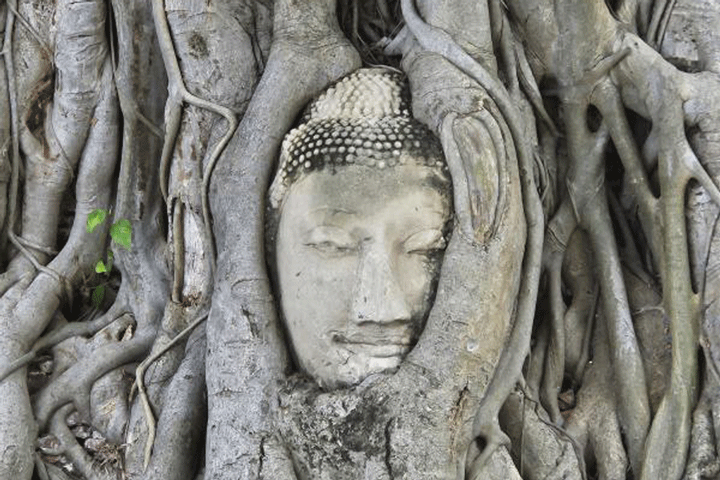I was reminded of the uselessness of the state-of-the-art phone camera — its lofty claims notwithstanding — when it comes to capturing great art, once again, ironically a few days after World Photography Day. The setting was distinctly photogenic.
I was visiting Ayutthaya — the old capital of imperial Siam — and stood surrounded by
the hypnotic splendour of the architectural remains of Buddhist shrines that had begun to be built by gifted artisans, one brick at a time, from around the mid-13th century. But the artworks — impossibly ornate columns, stupas embellished with bewitching murals, geometric arches, walls studded with motifs, statues, spires — even though they were only a few metres from where I stood, were proving to be deceptively elusive: they simply refused to be caged within the lens of the camera.
Consider the problem posed by the monumental statue called the Reclining Buddha at Wat Lokkayasutha, a figurine depicting the Enlightened One in a state of repose. The astoundingly crafted Buddha, its solemn head supported by an open palm, runs for a length of over 40 metres. When the camera zoomed in to capture it from head to toe, the feet jutted out of the frame; a close-up of the toes, quite naturally, left the head out. For a moment, struck by art’s ability to deceive technology, I thought the Buddha was smiling.

head of a Buddha statue (right) ensconced by the roots of an old fig tree. Uddalak Mukherjee
But then I was struck by what I thought was my moment of enlightenment. I decided to tip-toe backwards, one gingerly step at a time, in a bid to visually imprison the Buddha in a wide-angle shot. Alas, after a while, even though it seemed that I had walked backwards almost out of Ayutthaya, the reclining one still wouldn’t fit in the frame.
Wat Phra Ram, another relic of bedazzling medieval art, put the phone camera in its place equally comprehensively. If the camera managed to catch a single figure carved on a particular stupa, there would be 10 others — with gently mocking countenances — on the same structure that would stay out of the frame. The ritual of a failed courtship between art and camera was, of course, not limited to Ayutthaya: it had been played out in other historical sites in other corners. In Konark, I remember the danseuse, carved at an astonishing height, staying on my mind but out of the camera’s sight; in Bhubaneswar’s Rajarani shrine, the yakshi — they say Feluda had retrieved it on one of his adventures — had remained a blurry dot defying digital wizardry; Ajanta and Ellora’s luminescence could never quite be reproduced by the mechanical third eye; Varanasi and Kanchipuram, two cities of shrines, agreed to lend only miserly glimpses of their artistic abundance to the camera.

Ayutthaya in Thailand. Uddalak Mukherjee
So in Ayutthaya, I did what great art demands of us: disengage from the frenzied but futile pursuit of camera-trapping the shrines and try and absorb their sublime beauty through the human eye. It was a surreal moment, the moment of surrendering one’s sensory faculties — eye and ear for sight and ambient sound — to architecture that is simultaneously capacious and precise.
But then art also has the ability to conceal or deflect realities from the field of human vision. In Ayutthaya, as one walks around the splendid remains of the edifices, it is easy to be lulled into a sense of harmony, forgetting that this very place, once a bustling, cosmopolitan capital, had been razed to the ground by the invading Burmese army, never to recover its former sheen.
As with art, so with nature.
While crisscrossing Thailand’s countryside, tucked away from Bangkok and its urbane, hedonistic pleasures and marked by emerald stretches of fields and vegetation, meandering waterways, and a seemingly laconic way of life, it is equally easy to forget that the people, warm and hospitable to a fault in spite of their hardships, have had two of their popular leaders dismissed from power, in 2006 and 2014, by the
Establishment.
But as I jostled with chatty Chinese visitors and sombre Thai monks to photograph — there, I did it again! — the famed Buddha head entwined in the roots of a tree at Wat Mahathat, another of Ayutthaya’s enduring wonders, I forgot about Thailand’s evolving and not-quite-perfect tryst with democracy. That is because, for a
moment, I could not quite believe what I was seeing as I peered into my camera. The Buddha head, unlike numerous other artefacts, fit perfectly in the frame!
And there I stood, momentarily transfixed, a solitary Indian with a distinctly un-Buddha-like smile, amidst a throng of solemn East Asian neighbours.










